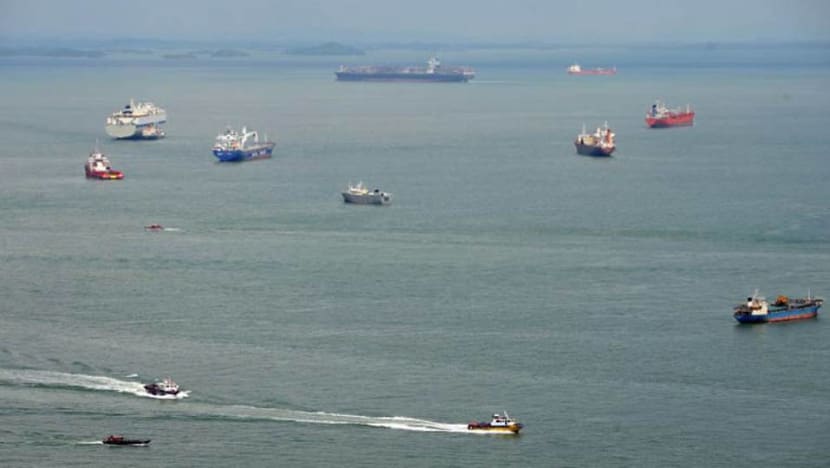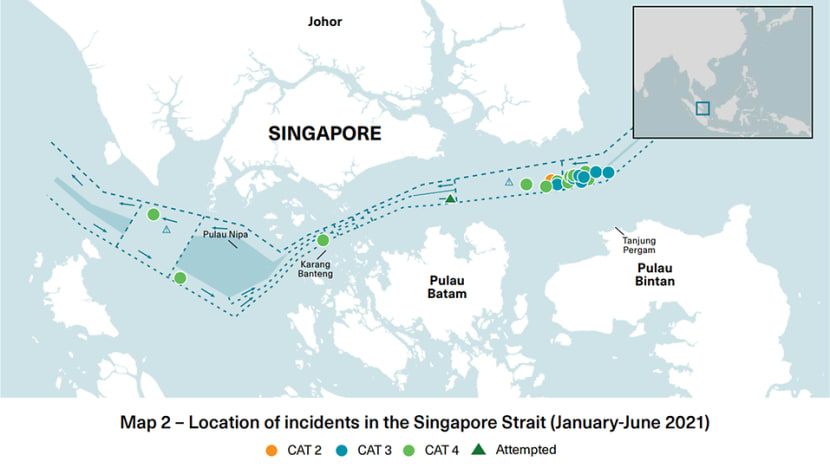Rise in sea robbery incidents in Singapore Strait despite overall drop in the region

File photo of the Singapore Strait. (Photo: AFP)
SINGAPORE: Armed robbery incidents on ships in the Singapore Strait rose in the first half of 2021, with the majority involving bigger vessels such as bulk carriers.
From January to June this year, a total of 20 armed robbery incidents took place within the Singapore Strait, up from 16 in the same period a year before, according to a maritime information sharing centre on Friday (Jul 16).
This was in contrast to a 35 per cent drop in the number of incidents in the region during the same period, said the Regional Cooperation Agreement on Combating Piracy and Armed Robbery against Ships in Asia (ReCAAP) Information Sharing Centre.
During first six months of the year, there were 37 armed robbery incidents in Asia, down from 57 in the same period last year, with fewer cases reported locations such as India, Indonesia, the Philippines and the South China Sea.
Mr Masafumi Kuroki, the centre’s executive director, said the “continued occurrence” of incidents on board ships in the Singapore Strait remains a concern, adding that incidents are likely to continue to occur if the perpetrators are not arrested.
READ: Sea robbery incidents in Singapore Strait rise again in 2020
INCIDENTS IN SINGAPORE STRAIT
Out of the incidents in the Singapore Strait, 16 took place in the eastbound lane of the Traffic Separation Scheme (TSS), in the waters off Tanjung Pergam, Bintan Island, Indonesia.
They occurred during hours of darkness on bulk carriers, tankers and a general cargo ship, said ReCAAP, adding that the majority of incidents involved groups of four men.
Seven incidents involved perpetrators with knives.

Speaking to reporters at a virtual briefing, Mr Kuroki said: “It is no longer petty theft, it is more serious crimes when perpetrators are armed with knives or other weapons or if crew is threatened or injured.
"So it is a concern for the maritime community that such incidents took place in the Singapore Strait."
He added that some of the incidents took place almost at the same time at different locations, indicating that there are likely several groups of perpetrators.
"STRENGTHENED RESPONSE"
Mr John Bradford, a senior fellow in the Maritime Security Programme at the S Rajaratnam School of International Studies (RSIS), noted that the waters off Tanjung Pergam have been the most dangerous part of the Singapore Strait, in terms of sea robberies.
“This is the Indonesian side of the Strait, closer to ports from which the criminals operate and where law enforcement capacity is generally less,” he told CNA in an email interview.
The trend of rising incidents in the Singapore Strait is also notable because ReCAAP numbers showed that robbery was “almost stamped out from 2016 to 2018,” he said.
“Since then, the rate of reported incidents has been increasing.”
This rise merits a “strengthened response”, said Mr Bradford, adding that it is important to stamp out any criminal activities before they become more problematic.
To address this issue, ReCAAP’s Mr Kuroki said: “What is important is to strengthen law enforcement efforts by the littoral states.”
He noted that law enforcement agencies of the three littoral states – Indonesia, Malaysia and Singapore – are already working together, and that he hopes they will continue to “enhance their efforts at coordination and cooperation”.
“At the same time, the shipping industry knows where the incidents are taking place. They have to enhance their vigilance in that area,” he said.
READ: Sea robbery incidents in Singapore Strait double in first half of 2020
OVERALL SITUATION
Overall, there were improvements in the region, noted ReCAAP.
There were no incidents of the highest severity level, Category 1, and just one incident in Category 2.
About 70 per cent of incidents were categorised as low level, where the perpetrators were not armed and the crew were not harmed.
ReCAAP added that there were no incidents involving the abduction of crew members in the Sulu-Celebes Seas and waters off Eastern Sabah during the first half of this year. The latest incident was in January 2020.
Over the past few years, the total number of actual and attempted abductions have also fallen, with none taking place in the past six months, noted ReCAAP.
But it added that the Abu Sayyaf Group, which was responsible for the abduction last January, is still at large.
Thus, the “threat of abduction of crew from ships remains high, particularly in the areas of Sulu and nearby waters off Tawi-Tawi,” it said.
Mr Bradford said that although authorities from the Philippines and Malaysia deserve some credit for having “neutralised key criminal leaders” from the Abu Sayyaf group, the risk of abductions is still a concern.
He added that the concerns stem from “international maritime boundaries where criminals can exploit seams between law enforcement and other governance activities”.
“Therefore the response must be coordinated internationally. It is important to improve this coordination and, especially, to ensure critical data is being shared reliably and safely,” he said.
STAYING VIGILANT
When asked about the role of COVID-19 on sea robbery incidents, Mr Kuroki said it has been “difficult” to make a link.
“Last year when there was COVID-19, the number of incidents increased in Asia, whereas for the first six months of this year, the number of incidents decreased in general in Asia.
"So it’s difficult to know if there is any impact of the pandemic on incidents,” he said.












